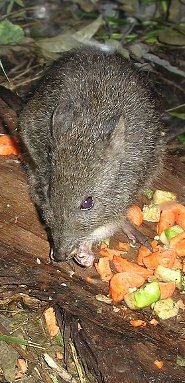 The Spinifex hopping mouse (Notomys alexis), which also goes by the name Tarkawara, is indigenous to western and central Australia. Their population is centered in arid regions such as the sand dunes, the spiniflex sand flats for which the animal is named, as well as melaleuca and mulga flats. They prefer dry environments and can migrate up to 15 kilometers during periods of intense rain.
The Spinifex hopping mouse (Notomys alexis), which also goes by the name Tarkawara, is indigenous to western and central Australia. Their population is centered in arid regions such as the sand dunes, the spiniflex sand flats for which the animal is named, as well as melaleuca and mulga flats. They prefer dry environments and can migrate up to 15 kilometers during periods of intense rain.The hopping mouse is similar in appearance to its relative, the Northern hopping mouse, and is slightly larger than the typical house mouse. It measures between 95 and 115 millimeters or 3.7 to 4.5 inches from head to the end of their body with the average weight being 35 grams or 1.2 ounces. The mouse has longer hind legs than the average mouse as well as shortened forelimbs with a longer than average tail, approximately 140 millimeters or 5.5 inches in length. Their fur is a fawn color with grey around the mouth as well as in the space between the ear and eye. Their hair is significantly courser and blacker on the back with the tail having very little fur.
The Spinifex hopping mouse lives in burrows which are typically located about 10 inches beneath the surface. The chamber in which the animals live is usually quite large and is lined with plant matter as well as small sticks.
The Spinifex hopping mouse breeds primarily in the spring although they are able to do so throughout the year. The gestation period is quite short, approximately 40 days but can vary depending on whether or not the pregnant mouse is still nursing its previous litter. The litter can vary in size with the average being 3 babies. After the babies are born, they remain in the den when the family goes to forage for food. Sexual maturity is obtained without 2 ½ months.
The usual predators of the hopping mouse are owls, dingoes, red foxes, and feral cats. The population can vary greatly with the population booming after rain and occasionally spreading out into different areas with the population decreasing during times of drought. Despite this, the species is currently not considered endangered.
Keywords: tail
The Spinefex hopping mouse is listed as Least Concern (LR/lc), lowest risk. Does not qualify for a more at risk category. Widespread and abundant taxa are included in this category, on the IUCN Red List of Threatened Species
Namings for the spinifex hopping mouse
A young / baby of a spinifex hopping mouse is called a 'pinkie, kitten or pup'. The females are called 'doe' and males 'buck'. A spinifex hopping mouse group is called a 'nest, colony, harvest, horde or mischief'.Countries
AustraliaSome facts about the
Australian hopping mouse
Adult weight : 0.035 kg (0.077 lbs)
Maximum longevity : 6 years
Female maturity :75 days
Male maturity : 75 days
Gestation : 35 days
Weaning : 30 days
Litter size : 4
Interval between litters : 33 days
Weight at birth : 0.003 kg (0.0066 lbs)
Weight at weaning : 0.013 kg (0.0286 lbs)
Body mass : 0.032 kg (0.0704 lbs)
Temperature : 37.85 °C (100.13 °F)

Custom Search